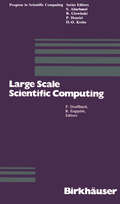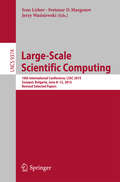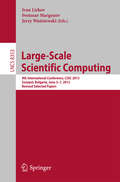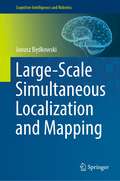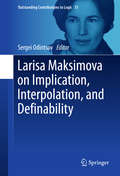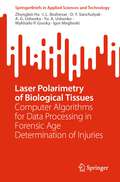- Table View
- List View
Large-Scale Quantum-Mechanical Enzymology (Springer Theses)
by Greg LeverThis work establishes linear-scaling density-functional theory (DFT) as a powerful tool for understanding enzyme catalysis, one that can complement quantum mechanics/molecular mechanics (QM/MM) and molecular dynamics simulations. The thesis reviews benchmark studies demonstrating techniques capable of simulating entire enzymes at the ab initio quantum-mechanical level of accuracy. DFT has transformed the physical sciences by allowing researchers to perform parameter-free quantum-mechanical calculations to predict a broad range of physical and chemical properties of materials. In principle, similar methods could be applied to biological problems. However, even the simplest biological systems contain many thousands of atoms and are characterized by extremely complex configuration spaces associated with a vast number of degrees of freedom. The development of linear-scaling density-functional codes makes biological molecules accessible to quantum-mechanical calculation, but has yet to resolve the complexity of the phase space. Furthermore, these calculations on systems containing up to 2,000 atoms can capture contributions to the energy that are not accounted for in QM/MM methods (for which the Nobel prize in Chemistry was awarded in 2013) and the results presented here reveal profound shortcomings in said methods.
Large-Scale Scientific Computations: 14th International Conference, LSSC 2023, Sozopol, Bulgaria, June 5–9, 2023, Revised Selected Papers (Lecture Notes in Computer Science #13952)
by Ivan Lirkov Svetozar MargenovThis book constitutes the refereed proceedings of the 14th International Conference on Large-Scale Scientific Computations, LSSC 2023, held in Sozopol, Bulgaria, during June 5–9, 2023. The 49 full papers included in this book were carefully reviewed and selected from 61 submissions. They were organized in topical sections as follows: preconditioning and multilevel methods; fractures and mixed dimensional modeling: discretizations, solvers, and methodology; machine learning and model order reduction for large scale predictive simulations; fractional differential problems: theoretical aspects, algorithms and applications; variational analysis and optimal control; stochastic optimal control and numerical methods in economics and finance; tensor methods for big data analytics and low-rank approximations of PDEs solutions; applications of metaheuristics to large-scale problems; large-scale models: numerical methods, parallel computations and applications; HPC and HPDA: algorithms and applications.
Large Scale Scientific Computing (Progress in Scientific Computing #7)
by DeuflhardIn this book, the new and rapidly expanding field of scientific computing is understood in a double sense: as computing for scientific and engineering problems and as the science of doing such computations. Thus scientific computing touches at one side mathematical modelling (in the various fields of applications) and at the other side computer science. As soon as the mathematical models de scribe the features of real life processes in sufficient detail, the associated computations tend to be large scale. As a consequence, interest more and more focusses on such numerical methods that can be expected to cope with large scale computational problems. Moreover, given the algorithms which are known to be efficient on a tradi tional computer, the question of implementation on modern supercomputers may get crucial. The present book is the proceedings of a meeting on "Large Scale Scientific Computing" , that was held a t the Oberwolfach Mathematical Institute (July 14-19, 1985) under the auspices of the Sonderforschungsbereich 123 of the University of Heidelberg. Participants included applied scientists with computational interests, numerical analysts, and experts on modern parallel computers. 'l'he purpose of the meeting was to establish a common under standing of recent issues in scientific computing, especially in view of large scale problems. Fields of applications, which have been covered, included semi-conductor design, chemical combustion, flow through porous media, climatology, seismology, fluid dynami. cs, tomography, rheology, hydro power plant optimization, subwil. y control, space technology.
Large-Scale Scientific Computing: 11th International Conference, LSSC 2017, Sozopol, Bulgaria, June 5-9, 2017, Revised Selected Papers (Lecture Notes in Computer Science #10665)
by Ivan Lirkov Svetozar MargenovThis book constitutes the thoroughly refereed post-conference proceedings of the 11th International Conference on Large-Scale Scientific Computations, LSSC 2017, held in Sozopol, Bulgaria, in June 2017. The 63 revised short papers together with 3 full papers presented were carefully reviewed and selected from 63 submissions.The conference presents results from the following topics: Hierarchical, adaptive, domain decomposition and local refinement methods;Robust preconditioning algorithms;Monte Carlo methods and algorithms;Numerical linear algebra;Control and optimization;Parallel algorithms and performance analysis;Large-scale computations of environmental, biomedical and engineering problems.The chapter 'Parallel Aggregation Based on Compatible Weighted Matching for AMG' is available open access under a CC BY 4.0 license.
Large-Scale Scientific Computing: 12th International Conference, LSSC 2019, Sozopol, Bulgaria, June 10–14, 2019, Revised Selected Papers (Lecture Notes in Computer Science #11958)
by Ivan Lirkov Svetozar MargenovThis book constitutes revised papers from the 12th International Conference on Large-Scale Scientific Computing, LSSC 2019, held in Sozopol, Bulgaria, in June 2019. The 70 papers presented in this volume were carefully reviewed and selected from 81 submissions. The book also contains two invited talks. The papers were organized in topical sections named as follows: control and optimization of dynamical systems; meshfree and particle methods; fractional diffusion problems: numerical methods, algorithms and applications; pore scale flow and transport simulation; tensors based algorithms and structures in optimization and applications; HPC and big data: algorithms and applications; large-scale models: numerical methods, parallel computations and applications; monte carlo algorithms: innovative applications in conjunctions with other methods; application of metaheuristics to large-scale problems; large scale machine learning: multiscale algorithms and performance guarantees; and contributed papers.
Large-Scale Scientific Computing: 13th International Conference, LSSC 2021, Sozopol, Bulgaria, June 7–11, 2021, Revised Selected Papers (Lecture Notes in Computer Science #13127)
by Ivan Lirkov Svetozar MargenovThis book constitutes revised selected papers from the 13th International Conference on Large-Scale Scientific Computing, LSSC 23021, which was held in Sozopol, Bulgaria, during June 7-11, 2021. The 60 papers included in this book were carefully reviewed and selected from a total of 73 submissions. The volume also includes two invited talks in full paper length. The papers were organized in topical sections as follows: Fractional diffusion problems: numerical methods, algorithms and applications; large-scale models: numerical methods, parallel computations and applications; application of metaheuristics to large-scale problems; advanced discretizations and solvers for coupled systems of partial differential equations; optimal control of ODEs, PDEs and applications; tensor and matrix factorization for big-data analysis; machine learning and model order reduction for large scale predictive simulations; HPC and big data: algorithms and applications; and contributed papers.
Large-Scale Scientific Computing: 10th International Conference, LSSC 2015, Sozopol, Bulgaria, June 8-12, 2015. Revised Selected Papers (Lecture Notes in Computer Science #9374)
by Ivan Lirkov Svetozar D. Margenov Jerzy WaśniewskiThis book constitutes the thoroughly refereed post-conference proceedings of the 10th International Conference on Large-Scale Scientific Computations, LSSC 2015, held in Sozopol, Bulgaria, in June 2015. The 49 revised full papers presented were carefully reviewed and selected from 64 submissions. The general theme for LSSC 2015 was Large-Scale Scientific Computing with a particular focus on the organized special sessions: enabling exascale computation; control and uncertain systems; computational microelectronics - from monte carlo to deterministic approaches; numerical methods for multiphysics problems; large-scale models: numerical methods, parallel computations and applications; mathematical modeling and analysis of PDEs describing physical problems; a posteriori error control and iterative methods for maxwell type problems; efficient algorithms for hybrid HPC systems; multilevel methods on graphs; and applications of metaheuristics to large-scale problems.
Large-Scale Scientific Computing: 6th International Conference, LSSC 2007, Sozopol, Bulgaria, June 5-9, 2007, Revised Papers (Lecture Notes in Computer Science #4818)
by Ivan Lirkov Svetozar D. Margenov Jerzy WasniewskiLarge-Scale Scientific Computing: 7th International Conference, LSSC 2009, Sozopol, Bulgaria, June 4-8, 2009 Revised Papers (Lecture Notes in Computer Science #5910)
by Ivan Lirkov Svetozar D. Margenov Jerzy WasniewskiLarge-Scale Scientific Computing: 5th International Conference, LSSC 2005, Sozopol, Bulgaria, June 6-10, 2005, Revised Papers (Lecture Notes in Computer Science #3743)
by Ivan Lirkov Svetozar D. Margenov Jerzy WasniewskiThis book constitutes the thoroughly refereed post-proceedings of the 5th International Conference on Large-Scale Scientific Computations, LSSC 2005, held in Sozopol, Bulgaria in June 2005. The 75 revised full papers presented together with five invited papers were carefully reviewed and selected for inclusion in the book. The papers are organized in topical sections.
Large-Scale Scientific Computing: 9th International Conference, LSSC 2013, Sozopol, Bulgaria, June 3-7, 2013. Revised Selected Papers (Lecture Notes in Computer Science #8353)
by Ivan Lirkov Svetozar Margenov Jerzy WaśniewskiThis book constitutes the thoroughly refereed post-conference proceedings of the 9th International Conference on Large-Scale Scientific Computations, LSSC 2013, held in Sozopol, Bulgaria, in June 2013. The 74 revised full papers presented together with 5 plenary and invited papers were carefully reviewed and selected from numerous submissions. The papers are organized in topical sections on numerical modeling of fluids and structures; control and uncertain systems; Monte Carlo methods: theory, applications and distributed computing; theoretical and algorithmic advances in transport problems; applications of metaheuristics to large-scale problems; modeling and numerical simulation of processes in highly heterogeneous media; large-scale models: numerical methods, parallel computations and applications; numerical solvers on many-core systems; cloud and grid computing for resource-intensive scientific applications.
Large-Scale Scientific Computing: Third International Conference, LSSC 2001, Sozopol, Bulgaria, June 6-10, 2001. Revised Papers (Lecture Notes in Computer Science #2179)
by Svetozar D. Margenov Jerzy Wasniewski Plamen YalamovLarge-Scale Scientific Computing: 4th International Conference, LSSC 2003, Sozopol, Bulgaria, June 4-8, 2003, Revised Papers (Lecture Notes in Computer Science #2907)
by Yalamov Plamen Ivan Lirkov Svetozar D. Margenov Jerzy WasniewskiLarge-Scale Scientific Computing: 8th International Conference, LSSC 2011, Sozopol, Bulgaria, June 6-10th, 2011. Revised Selected Papers (Lecture Notes in Computer Science #7116)
by Jerzy Wasniewski Ivan Lirkov Svetozar D. MargenovThis book constitutes the thoroughly refereed post-conference proceedings of the 8th International Conference on Large-Scale Scientific Computations, LSSC 2011, held in Sozopol, Bulgaria, in June 2011. The 74 revised full papers presented together with 3 plenary and invited papers were carefully reviewed and selected from numerous submissions. The papers are organized in topical sections on robust multigrid, multilevel and multiscale, deterministic and stochastic methods for modeling highly heterogeneous media, advanced methods for transport, control and uncertain systems, applications of metaheuristics to large-scale problems, environmental modelling, large scale computing on many-core architectures, multiscale industrial, enviromental and biomedical problems, efficient algorithms of computational geometry, high performance Monte Carlo simulations, voxel based computations and contributed papers.
Large-Scale Simulation: Models, Algorithms, and Applications
by Dan Chen Lizhe Wang Jingying ChenLarge-Scale Simulation: Models, Algorithms, and Applications gives you firsthand insight on the latest advances in large-scale simulation techniques. Most of the research results are drawn from the authors’ papers in top-tier, peer-reviewed, scientific conference proceedings and journals. The first part of the book presents the fundamentals of large-scale simulation, including high-level architecture and runtime infrastructure. The second part covers middleware and software architecture for large-scale simulations, such as decoupled federate architecture, fault tolerant mechanisms, grid-enabled simulation, and federation communities. In the third part, the authors explore mechanisms—such as simulation cloning methods and algorithms—that support quick evaluation of alternative scenarios. The final part describes how distributed computing technologies and many-core architecture are used to study social phenomena. Reflecting the latest research in the field, this book guides you in using and further researching advanced models and algorithms for large-scale distributed simulation. These simulation tools will help you gain insight into large-scale systems across many disciplines.
Large-Scale Simulation: Models, Algorithms, and Applications
by Dan Chen Lizhe Wang Jingying ChenLarge-Scale Simulation: Models, Algorithms, and Applications gives you firsthand insight on the latest advances in large-scale simulation techniques. Most of the research results are drawn from the authors’ papers in top-tier, peer-reviewed, scientific conference proceedings and journals. The first part of the book presents the fundamentals of large-scale simulation, including high-level architecture and runtime infrastructure. The second part covers middleware and software architecture for large-scale simulations, such as decoupled federate architecture, fault tolerant mechanisms, grid-enabled simulation, and federation communities. In the third part, the authors explore mechanisms—such as simulation cloning methods and algorithms—that support quick evaluation of alternative scenarios. The final part describes how distributed computing technologies and many-core architecture are used to study social phenomena. Reflecting the latest research in the field, this book guides you in using and further researching advanced models and algorithms for large-scale distributed simulation. These simulation tools will help you gain insight into large-scale systems across many disciplines.
Large-Scale Simultaneous Localization and Mapping (Cognitive Intelligence and Robotics)
by Janusz BędkowskiThis book is dedicated for engineers and researchers who would like to increase the knowledge in area of mobile mapping systems. Therefore, the flow of the derived information is divided into subproblems corresponding to certain mobile mapping data and related observations’ equations. The proposed methodology is not fulfilling all SLAM aspects evident in the literature, but it is based on the experience within the context of the pragmatic and realistic applications. Thus, it can be supportive information for those who are familiar with SLAM and would like to have broader overview in the subject.The novelty is a complete and interdisciplinary methodology for large-scale mobile mapping applications. The contribution is a set of programming examples available as supportive complementary material for this book. All observation equations are implemented, and for each, the programming example is provided. The programming examples are simple C++ implementations that can be elaborated by students or engineers; therefore, the experience in coding is not mandatory.Moreover, since the implementation does not require many additional external programming libraries, it can be easily integrated with any mobile mapping framework. Finally, the purpose of this book is to collect all necessary observation equations and solvers to build computational system capable providing large-scale maps.
Large-Scale Software Architecture: A Practical Guide using UML
by Jeff Garland Richard AnthonyThe purpose of large-scale software architecture is to capture and describe practical representations to make development teams more effective. In this book the authors show how to utilise software architecture as a tool to guide the development instead of capturing the architectural details after all the design decisions have been made. * Offers a concise description of UML usage for large-scale architecture * Discusses software architecture and design principles * Technology and vendor independent
Large-Scale Structure of the Universe: Cosmological Simulations and Machine Learning (Springer Theses)
by Kana MoriwakiLine intensity mapping (LIM) is an observational technique that probes the large-scale structure of the Universe by collecting light from a wide field of the sky. This book demonstrates a novel analysis method for LIM using machine learning (ML) technologies. The author develops a conditional generative adversarial network that separates designated emission signals from sources at different epochs. It thus provides, for the first time, an efficient way to extract signals from LIM data with foreground noise. The method is complementary to conventional statistical methods such as cross-correlation analysis. When applied to three-dimensional LIM data with wavelength information, high reproducibility is achieved under realistic conditions. The book further investigates how the trained machine extracts the signals, and discusses the limitation of the ML methods. Lastly an application of the LIM data to a study of cosmic reionization is presented. This book benefits students and researchers who are interested in using machine learning to multi-dimensional data not only in astronomy but also in general applications.
Large-Scale Visual Geo-Localization (Advances in Computer Vision and Pattern Recognition)
by Amir R. Zamir Asaad Hakeem Luc Van Gool Mubarak Shah Richard SzeliskiThis timely and authoritative volume explores the bidirectional relationship between images and locations. The text presents a comprehensive review of the state of the art in large-scale visual geo-localization, and discusses the emerging trends in this area. Valuable insights are supplied by a pre-eminent selection of experts in the field, into a varied range of real-world applications of geo-localization. Topics and features: discusses the latest methods to exploit internet-scale image databases for devising geographically rich features and geo-localizing query images at different scales; investigates geo-localization techniques that are built upon high-level and semantic cues; describes methods that perform precise localization by geometrically aligning the query image against a 3D model; reviews techniques that accomplish image understanding assisted by the geo-location, as well as several approaches for geo-localization under practical, real-world settings.
Larisa Maksimova on Implication, Interpolation, and Definability (Outstanding Contributions to Logic #15)
by Sergei OdintsovThis edited volume focuses on the work of Professor Larisa Maksimova, providing a comprehensive account of her outstanding contributions to different branches of non-classical logic. The book covers themes ranging from rigorous implication, relevance and algebraic logic, to interpolation, definability and recognizability in superintuitionistic and modal logics. It features both her scientific autobiography and original contributions from experts in the field of non-classical logics. Professor Larisa Maksimova's influential work involved combining methods of algebraic and relational semantics. Readers will be able to trace both influences on her work, and the ways in which her work has influenced other logicians. In the historical part of this book, it is possible to trace important milestones in Maksimova’s career. Early on, she developed an algebraic semantics for relevance logics and relational semantics for the logic of entailment. Later, Maksimova discovered that among the continuum of superintuitionisitc logics there are exactly three pretabular logics. She went on to obtain results on the decidability of tabularity and local tabularity problems for superintuitionistic logics and for extensions of S4. Further investigations by Maksimova were aimed at the study of fundamental properties of logical systems (different versions of interpolation and definability, disjunction property, etc.) in big classes of logics, and on decidability and recognizability of such properties. To this end she determined a powerful combination of algebraic and semantic methods, which essentially determine the modern state of investigations in the area, as can be seen in the later chapters of this book authored by leading experts in non-classical logics. These original contributions bring the reader up to date on the very latest work in this field.
Laser Physics at the Limits
by Norman F. Ramsey Steven Chu Carl E. WiemanPublished on the occasion of Theodor Hänsch's 60th Birthday emphasis is placed on precision related to results in a variety of fields, such as atomic clocks, frequency standards, and the measurement of physical constants in atomic physics. Furthermore, illustrations and engineering applications of the fundamentals of quantum mechanics are widely covered. It has contributions by Nobel prize winners Norman F. Ramsey, Steven Chu, and Carl E. Wieman.
Laser Polarimetry of Biological Tissues: Computer Algorithms for Data Processing in Forensic Age Determination of Injuries (SpringerBriefs in Applied Sciences and Technology)
by Zhengbin Hu I.L. Bezhenar O.Y. Vanchulyak A. G. Ushenko Yu. A. Ushenko Mykhailo P. Gorsky Igor MeglinskiThis book highlights the results of numerical computer-aided smart methods as part of a comprehensive statistical, correlated, and fractal analysis of laser polarimetry. It includes a comprehensive approach to differentiation of lifelong or postmortem origin of injuries and determination of their antiquity based on the analysis of statistical and spatiotemporal frequency evolution of photometric, polarization, and phase parameters of laser images of histological sections of the skin of biomannequins. It discusses the relationship between the coordinate distributions of the intensity of laser images from skin tissues of biomannequins and the nature of its damage. It presents the analysis of relationships between changes in the mean and variance of coordinate distributions of azimuths and ellipticity of polarization images of histological skin sections and the time intervals after injury. Complex differentiation of lifelong and postmortem skin injuries of biomannequins and establishment of their time intervals throughout the entire monitoring interval of changes in the mean and variance of coordinate distributions of phase shifts between orthogonal components of the amplitude of laser images of a series of corresponding histological sections are also presented in this book.
Laser Printer (large print)
by RnibThis page shows an image of a laser printer viewed from the front. It is on the right of the page with descriptive labels to the left. There is a locator dot shown, which will be at the top left of the page when the image is the right way up. At the bottom right of the page is the body of the printer with two paper drawers, four control buttons and an LCD display. At the top of the page is a sheet of printed paper emerging from the printer with two arrows showing its direction of travel.
Laser Printer (UEB contracted)
by RnibThis page shows an image of a laser printer viewed from the front. It is on the right of the page with descriptive labels to the left. There is a locator dot shown, which will be at the top left of the page when the image is the right way up. At the bottom right of the page is the body of the printer with two paper drawers, four control buttons and an LCD display. At the top of the page is a sheet of printed paper emerging from the printer with two arrows showing its direction of travel.


